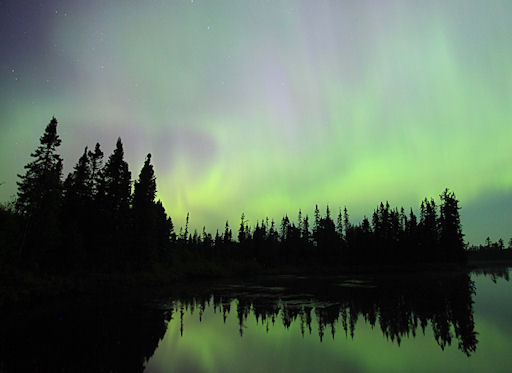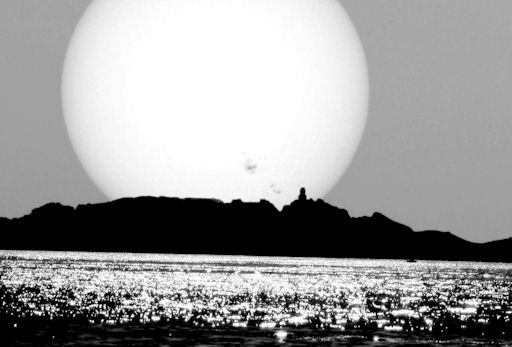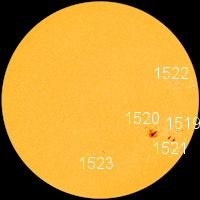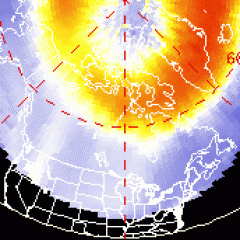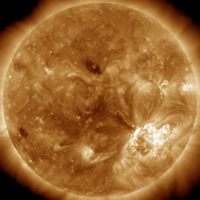~Space Weather Update~ Subsiding Storm~ [1]
SUBSIDING STORM: The geomagnetic storm of July 14th through 16th is subsiding. Solar wind conditions are trending toward quiet, and Earth's magnetic field is responding by settling down. The remarkable 36-hour event was triggered by a CME impact on July 14th around 11 am PDT (1800 UT).
When the CME first arrived on July 14th, its effect appeared weak. However, conditions in the wake of the CME soon become stormy. On July 14-16 Northern Lights appeared in the United States as far south as Oregon [2], California [3], Colorado [4], Missouri [5], Utah [6], Wisconsin [7], Iowa [8], Minnesota [9], Washington [10], Illinois [11], Kansas [12], South Dakota [13], Nebraska [14], Michigan [15] and Arkansas [16]. Travis Novitsky sends this picture from Grand Portage, Minnesota:
"Anticipating the CME's arrival on Saturday, I planned an Aurora Party with my girlfriend and a couple of friends," says Novitsky. "Just after midnight the sky erupted and suddenly we were surrounded by the shimmering, dancing lights. The intense activity continued through the rest of the night until the first light of dawn started to creep into the sky. Certainly one of the most amazing aurora nights I've ever witnessed in northern Minnesota!" Aurora alerts: text [18], voice [19].
Meanwhile in the southern hemisphere, the aurora australis has been sighted in New Zealand [20], Tasmania [21], and directly above the South Pole [22] itself. Visit our aurora gallery for a complete set of images:
Realtime Aurora Photo Gallery [23]
THE SOURCE OF THE DISPLAY: Big sunspot AR1520, the source of the X-flare that instigated this weekend's auroras, can attract observers even without exploding. During a quiet moment yesterday in France, it showed itself at sunset:
Photographer VegaStar Carpentier took the picture on July 15th overlooking an island near the Coast of Marseilles.
The behemoth sunspot has a beta-gamma-delta magnetic field that harbors energy for more X-class solar flares. The odds of a geoeffective eruption are decreasing, however, as the sunspot turns toward Earth. NOAA forecasters estimate a 40% chance of M-flares and a 15% chance of X-flares during the next 24 hours. Solar flare alerts: text [18], voice [19].

![]()
Solar wind
speed: 428.3 km/sec
density: 0.3 protons/cm3
explanation [25] | more data [26]
Updated: Today at 1526 UT
![]()
X-ray Solar Flares
6-hr max: C2 1310 UT Jul16
24-hr: C3 0458 UT Jul16
explanation [27] | more data [28]
Updated: Today at: 1500 UT
![]()
![]()
![]()
Daily Sun: 16 Jul 12
![]()
![]()
Sunspot 1520 poses a continued threat for X-class [27] solar flares. As the sunspot turns away from Earth, however, the chances of a geoeffective eruption are decreasing. Credit: SDO/HMI
![]()
![]()
![]()
Sunspot number: 134
What is the sunspot number? [30]
Updated 15 Jul 2012
Spotless Days
Current Stretch: 0 days
2012 total: 0 days (0%)
2011 total: 2 days (<1%)
2010 total: 51 days (14%)
2009 total: 260 days (71%)
Since 2004: 821 days
Typical Solar Min: 486 days
Updated 15 Jul 2012
The Radio Sun
10.7 cm flux: 148 sfu
explanation [31] | more data [32]
Updated 15 Jul 2012
![]()
![]()
![]()
Current Auroral Oval:
![]()
Switch to: Europe, USA, New Zealand, Antarctica
Credit: NOAA/POES
![]()
![]()
![]()
Planetary K-index
Now: Kp= 4 unsettled
24-hr max: Kp= 6 storm
explanation [34] | more data [35]
![]()
Interplanetary Mag. Field
Btotal: 11.0 nT
Bz: 4.1 nT north
explanation [36] | more data [37]
Updated: Today at 1526 UT
![]()
![]()
![]()
Coronal Holes: 14 Jul 12
![]()
![]()
There are no large coronal holes on the Earthside of the sun. Credit: SDO/AIA.
Category:
- Economic News [39]
